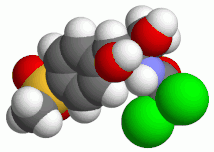Loading AI tools
Antibiotic From Wikipedia, the free encyclopedia
Thiamphenicol (also known as thiophenicol and dextrosulphenidol) is an antibiotic.[1] It is the methyl-sulfonyl analogue of chloramphenicol and has a similar spectrum of activity, but is 2.5 to 5 times as potent. Like chloramphenicol, it is insoluble in water, but highly soluble in lipids. It is used in many countries as a veterinary antibiotic, but is available in China, Morocco and Italy for use in humans. Its main advantage over chloramphenicol is that it has never been associated with aplastic anaemia.[2]
 | |
 | |
| Clinical data | |
|---|---|
| Trade names | Urfamycin |
| AHFS/Drugs.com | International Drug Names |
| Routes of administration | IV, IM, oral |
| ATC code | |
| Pharmacokinetic data | |
| Metabolism | hepatic |
| Elimination half-life | 5.0 hours |
| Excretion | renal |
| Identifiers | |
| |
| CAS Number | |
| PubChem CID | |
| DrugBank | |
| ChemSpider | |
| UNII | |
| KEGG | |
| ChEBI | |
| ChEMBL | |
| CompTox Dashboard (EPA) | |
| ECHA InfoCard | 100.035.762 |
| Chemical and physical data | |
| Formula | C12H15Cl2NO5S |
| Molar mass | 356.21 g·mol−1 |
| 3D model (JSmol) | |
| Melting point | 164.3 to 166.3 °C (327.7 to 331.3 °F) |
| |
| |
| | |
Thiamphenicol is also widely used in Brazil, particularly for the treatment of sexually transmitted infections such as pelvic inflammatory disease.[3]
Unlike chloramphenicol, thiamphenicol is not readily metabolized in cattle, poultry, sheep, or humans, but is predominantly excreted unchanged. In pigs and rats the drug is excreted both as parent drug and as thiamphenicol glucuronate.[2]
Thiamphenicol can be administered as a part of a complex molecule, Thiamphenicol glycinate acetylcysteine.[4]
Seamless Wikipedia browsing. On steroids.
Every time you click a link to Wikipedia, Wiktionary or Wikiquote in your browser's search results, it will show the modern Wikiwand interface.
Wikiwand extension is a five stars, simple, with minimum permission required to keep your browsing private, safe and transparent.